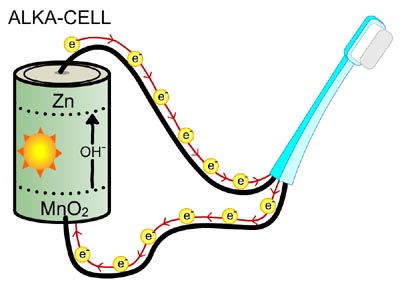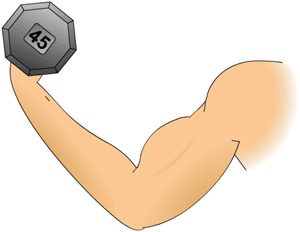|
||||||||||||
|
|
||||||||||||
Redox ReactionsEnergy on Tap
Here’s an example. Let’s say you buy some alkaline batteries to power your electric toothbrush. When you hit the "on" switch, how do batteries generate the electricity to run that gadget? The battery has zinc powder at one end, and manganese dioxide at the other end. The two ends are connected by a potassium hydroxide (KOH) solution that provides OH- ions.
The electrons flow out of the battery, and this electric current powers those motorized bristles, letting you get those pearly whites sparkling clean. Moving along the circuit, the electrons then re-enter the battery:
The OH- ions are regenerated, and are free to flow through the KOH solution to the Zn to generate more electrons.
For example, let’s say you start to get ready for the upcoming ski season by doing some leg lifts. Under non-strenuous conditions, aerobic metabolism uses O2 to generate ATP to power the muscle. However, during vigorous exercise where O2 demand is very high in the muscles, an interesting reaction called homolactic fermentation is responsible for allowing our muscles to keep working hard even when oxygen starts to run low (such as by the time you get to your 100th leg lift!). The overall reaction is: Pyruvate + NADH + H+ This is a redox reaction that consists of two half reactions:
The NAD+ that is generated is then used in other metabolic reactions to generate more ATP. The lactate (lactic acid) generated by this reaction is believed to be responsible for the "burn" that you feel in muscles that you worked too hard. |
 |
Copyright 2006, John Wiley & Sons Publishers, Inc. |
 |
 Redox reactions are powerful things. That’s not just a figure of speech. Redox reactions really are useful for generating power. Remember how we defined redox reactions as being comprised of the transfer of electrons? That’s exactly what electricity is, the movement of electrons. You may have noticed that the reduction potential (E0) of half reactions is in Volts, which we use as a measure of electricity?
Redox reactions are powerful things. That’s not just a figure of speech. Redox reactions really are useful for generating power. Remember how we defined redox reactions as being comprised of the transfer of electrons? That’s exactly what electricity is, the movement of electrons. You may have noticed that the reduction potential (E0) of half reactions is in Volts, which we use as a measure of electricity? Your body uses redox reactions to create energy, too, although in a different way. The majority of the energy generated in our bodies comes from aerobic metabolism, which uses the O2 that we breathe to "burn" the fuel that we eat. The oxidation of compounds such as carbohydrates in redox reactions makes the generation of ATP, our "energy currency", possible. There are other energy-producing redox reactions in the body that do not utilize oxygen directly.
Your body uses redox reactions to create energy, too, although in a different way. The majority of the energy generated in our bodies comes from aerobic metabolism, which uses the O2 that we breathe to "burn" the fuel that we eat. The oxidation of compounds such as carbohydrates in redox reactions makes the generation of ATP, our "energy currency", possible. There are other energy-producing redox reactions in the body that do not utilize oxygen directly.